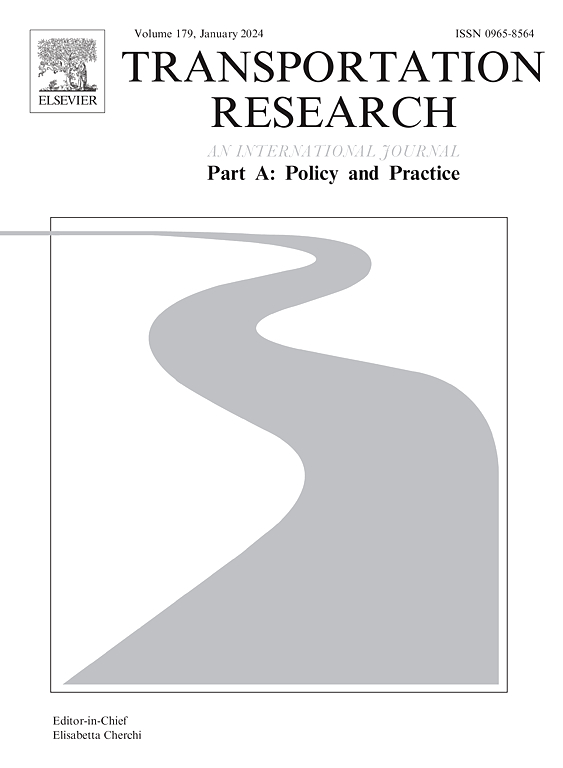How has COVID-19 changed individuals’ e-commerce and shopping mobility habits? Evidence from Madrid Region
IF 6.3
1区 工程技术
Q1 ECONOMICS
Transportation Research Part A-Policy and Practice
Pub Date : 2024-10-31
DOI:10.1016/j.tra.2024.104295
引用次数: 0
Abstract
The use of e-commerce has grown exponentially in recent years, driven by the increase in Internet connectivity and the spread of electronic payment mechanisms. Lockdowns and social distancing measures imposed during the COVID-19 health crisis led to an extra growth in the use of e-shopping among the population, some of which has continued after the end of the pandemic. E-commerce practices have been found to influence mobility patterns of individuals, with many contributions having analyzed their effects on shopping trips before the pandemic and during COVID waves. However, there is a need to understand the lasting changes in individuals’ patterns of e-commerce as well as their subsequent impact on mobility in the aftermath of the pandemic. To that end, this research takes advantage of a macro survey campaign in the Region of Madrid, Spain between October and November 2022, collecting 15,666 valid responses in a fully post-COVID timeframe. This information was exploited to build a Generalized Structural Equation Model (GSEM) that explores individuals’ patterns of e-commerce use in two different time periods, pre- and post-COVID, with the aim of studying to what extent changes in e-commerce and shopping habits have modified individuals’ mobility patterns. The research concludes a positive, albeit modest, effect of the pandemic on e-commerce usage among the population, as well as an increased preference for shopping physically close to home. Reductions in shopping mobility are greater among intensive users of e-commerce and people who before COVID mainly used the private car or public transport for shopping trips, thus suggesting a positive impact on sustainability from the demand side. The paper provides additional insights on the relationships between shopping habits, e-commerce use, and reductions in the mobility of individuals due to the availability of e-commerce, of interest to researchers and policymakers.
COVID-19 如何改变了个人的电子商务和购物流动习惯?马德里地区的证据
近年来,随着互联网连接的增加和电子支付机制的普及,电子商务的使用呈指数级增长。在 COVID-19 健康危机期间实施的封锁和社会疏远措施导致民众使用电子购物的额外增长,其中一些在疫情结束后仍在继续。人们发现电子商务会影响个人的流动模式,许多研究都分析了电子商务对大流行前和 COVID 期间购物旅行的影响。然而,我们有必要了解个人电子商务模式的持久变化及其对大流行后流动性的后续影响。为此,本研究利用了 2022 年 10 月至 11 月期间在西班牙马德里大区开展的一项宏观调查活动,收集了 15,666 份有效问卷,这些问卷的时间跨度完全在世界艾滋病病毒/艾滋病大流行之后。研究利用这些信息建立了一个广义结构方程模型(GSEM),探讨了个人在两个不同时间段(COVID 前后)的电子商务使用模式,旨在研究电子商务和购物习惯的变化在多大程度上改变了个人的流动模式。研究得出的结论是,大流行病对人们使用电子商务产生了积极影响,尽管影响不大,但人们更倾向于就近购物。电子商务密集型用户和在 COVID 之前主要使用私家车或公共交通工具购物的人的购物流动性降低幅度更大,这表明需求方面对可持续性产生了积极影响。本文为研究人员和政策制定者提供了更多关于购物习惯、电子商务使用以及电子商务的使用导致个人流动性降低之间关系的见解。
本文章由计算机程序翻译,如有差异,请以英文原文为准。
求助全文
约1分钟内获得全文
求助全文
来源期刊
CiteScore
13.20
自引率
7.80%
发文量
257
审稿时长
9.8 months
期刊介绍:
Transportation Research: Part A contains papers of general interest in all passenger and freight transportation modes: policy analysis, formulation and evaluation; planning; interaction with the political, socioeconomic and physical environment; design, management and evaluation of transportation systems. Topics are approached from any discipline or perspective: economics, engineering, sociology, psychology, etc. Case studies, survey and expository papers are included, as are articles which contribute to unification of the field, or to an understanding of the comparative aspects of different systems. Papers which assess the scope for technological innovation within a social or political framework are also published. The journal is international, and places equal emphasis on the problems of industrialized and non-industrialized regions.
Part A''s aims and scope are complementary to Transportation Research Part B: Methodological, Part C: Emerging Technologies and Part D: Transport and Environment. Part E: Logistics and Transportation Review. Part F: Traffic Psychology and Behaviour. The complete set forms the most cohesive and comprehensive reference of current research in transportation science.

 求助内容:
求助内容: 应助结果提醒方式:
应助结果提醒方式:


